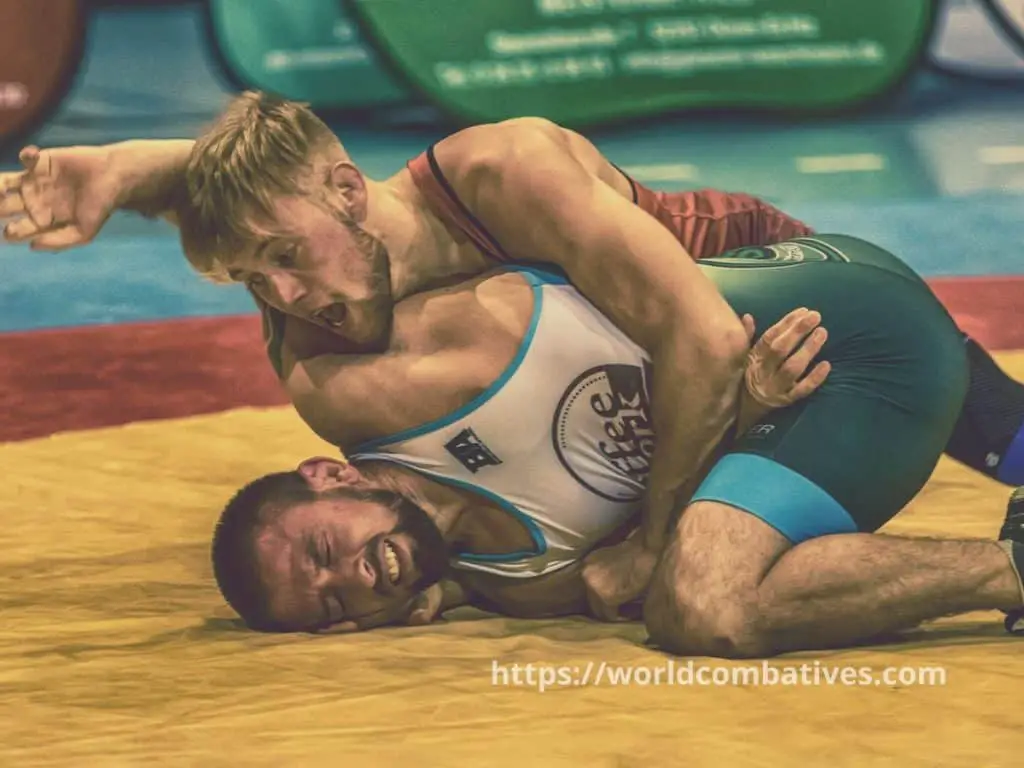11 Different Wrestling Types and Styles Explained: Popularity, Main Types, Differences, etc.
Wrestling has been around for 15,000 years, from the ancient kingdom of Babylon to our current era. Thus, the sport branched out to multiple styles across different cultures worldwide. Among these styles, three are considered the main types of Wrestling: Folkstyle, Freestyle, and Greco-Roman. Here is a table summary of their key differences.
| Folkstyle | Freestyle | Greco-Roman | |
| Other Names | Traditional Wrestling, Collegiate Wrestling, Scholastic Wrestling | Catch-as-catch-can Wrestling | French Wrestling, Flat-hand Wrestling |
| Focus | Controlling Opponents | Exposure Points | Transitions, Fluidity, and Throws |
| Unique Differences | Used to get Healthy Exercise | Trips and Scissors Moves | Holding Below Waist Isn’t allowed |
| Score System | Takedowns | Elbow Rolls, Falling, Takedowns | Body locks, Throws, Rolls |
This blog post will discuss the differences between these three wrestling styles. We will also discuss the most and least popular and other wrestling styles common to certain places worldwide.

What are the Similarities and Differences between Folkstyle, Freestyle, and Greco-Roman Wrestling?
The similarity between Folkstyle, Freestyle, and Greco-Roman Wrestling is that all three have the main goal, which is to pin their opponents. They also have turns, pins, and takedowns, as is common in all wrestling forms. However, how they pin their opponents differ in each Wrestling style.
First, let’s talk about the similarities between the main wrestling styles. For one, these styles don’t use strikes. Most of them are a form of grappling martial art.
Granted that a minor wrestling style uses strikes, these three don’t use them. Later, we will talk about the wrestling style that allows strikes, Shuai Jiao.
However, the standard wrestling moves such as turns, pins, and takedowns are similar to all these three.
Their similarities end here are we discuss the uniqueness of each wrestling style.
Freestyle wrestling focuses on tips and scissor moves because it is a type of Wrestling that uses the legs for offense and defense.
Interestingly, getting points in Freestyle wrestling is easier than in other wrestling types, as a simple elbow roll will give you points in the match.
Freestyle wrestling is also very common in that it has been one of the two wrestling types that have appeared in the Olympics since 1904.
Some people call Freestyle Wrestling the Catch-as-catch-can Wrestling or Catch Wrestling because it has its roots in the said sport. However, Catch Wrestling has a broader scope as minor wrestling types such as Pehlwani Wrestling belong to the Catch wrestling category.

Folkstyle is usually done in schools as a form of exercise. It is also known as Traditional Wrestling, Collegiate Wrestling, and Scholastic Wrestling because it is generally practiced in schools.
Compared to freestyle, Folkstyle Wrestling focuses on takedowns to win a match. Thus, points are easier in freestyle as points are immediately given when your opponent falls or gets an elbow roll.
You’ll most likely learn Folkstyle Wrestling if you enroll in a wrestling class.
Greco-Roman wrestling is another type of Wrestling that is present in the Olympics. In fact, it appeared in the Olympics earlier than freestyle wrestling.
Greco-Roman wrestling has been in the Olympics since 1896. This type of Wrestling focuses on the upper body as touching anything below the waist isn’t allowed in this wrestling style.
Thus, scores in Greco-Roman are acquired using upper body locks, throws, and rolls on their opponents.
Now that you have a brief introduction to these wrestling styles, one question that might pop into your mind is which among these is the most popular. Where are these martial arts most common? Let’s discuss that in the next section.
What is the most common type of Wrestling?
Freestyle wrestling is the most common wrestling style worldwide, and they’re common in Russia, Mongolia, Canada, Brazil, India, and Africa. The second most common Wrestling is Greco-Roman Wrestling, which is widespread in Australia, Argentina, Mexico, and the UK. Finally, folkstyle Wrestling is the 3rd most common, which dominates in the USA.
Knowing the most common type of Wrestling is so easy that we only need to ask Google about it.
A graph from Google indicates which of these three main Wrestling types is the most common.

As you can see, based on the data, Freestyle wrestling is the most popular, followed by Greco-Roman, then Folkstyle Wrestling.
However, knowing this doesn’t solve anything. We should also know which Wrestling is popular in our area.
The good news is we can also get that data.

As you can see from the data above, Freestyle wrestling seems more common globally and is the most popular wrestling style in Canada, Brazil, Mongolia, Russia, India, and Africa.
Interestingly, Greco-Roman wrestling is more common in Australia, the UK, Mexico, and Argentina.
Lastly, Folkstyle Wrestling is very common in the USA.
With these in mind, let’s briefly discuss the minor wrestling styles.

Other Wrestling Types
While there are three main wrestling types, its 15,000-year history has led to a lot of variety in the sport. We will discuss each of the wrestling styles below.
1. Professional Wrestling
If you’re wondering why you haven’t read about the Wrestling seen on TV, that is because professional Wrestling is considered a different type of Wrestling.
This is the Wrestling you’ll likely see on TV with flashy moves and a steel chair.
Sadly, the professional Wrestling you see on TV is usually scripted matches, and its goal is to get as flashy as possible to get more viewers.
While that is the case, it is still a type of Wrestling, and learning how to be a professional wrestler can be harder than learning other styles since you need to build a solid charisma to gather an audience.
Recommended Read: Did you know why professional Wrestling became fake? I created a post discussing its history, which you can read if you’re interested here: How did Wrestling become fake?
2. Sumo Wrestling
You might’ve heard of wrestling matches in Japan where two people weighing more than 150 lbs wrestle. This is called Sumo wrestling.
Sumo Wrestling is interesting as it is a type of Wrestling where one of the combatant’s conditioning is eating as many calories as possible to be big.
In Sumo wrestling, being heavier is an advantage as it prevents them from falling or getting outside the marked circle or line.
To win a sumo match, a wrestler should force his opponent outside a marked circle or by making him touch the ground with any part of his body except the soles of his feet.
3. Shuai Jiao Wrestling
Shuai Jiao is the Chinese version of Wrestling that started in Beijing. Shuai Jiao in English translates to “throw and trip,” which is the focus of their wrestling matches.
Shuai Jiao is an old martial art traced to 400 years ago in the Qing dynasty.
Compared to other forms of Wrestling, Shuai Jiao might be one of the few wrestling styles where strikes are allowed, particularly in the Tianjin province of China.
4. Bokh Wrestling
Bokh is Mongolia’s form of Wrestling. Bokh, when translated in Mongolia, means Wrestling. It came from the Mongolian word Beku which means “strong man.”
Bokh is also known as Jacket or Mongolian Wrestling.
Bokh Wrestling significantly impacts Mongolia’s culture because it is considered one of their Three Manly skills.
Interestingly, Genghis Khan also used it to keep his soldiers in shape.
5. Cumberland Wrestling
Cumberland Wrestling is a style of Wrestling developed in northern England and southern Scotland.
The matches usually start with wrestlers locking their hands on each other’s bodies. After this, an umpire gives the word to start the match.
The match ends when one person touches the ground other than their feet. If both contestants touch the ground simultaneously, the one on top is declared the winner.
Cumberland wrestling is also known as Westmorland Wrestling.
6. Sambo
Sambo is a very popular martial art. It is considered the Russian style of wrestling and has been included by United World Wrestling in the World Wrestling Championships along with Greco-Roman wrestling and freestyle wrestling.
Sambo is now international Wrestling and has a series of rules for worldwide competitions.
Compared to other Wrestling types, Sambo is relatively new and only began in the 1920s. It was developed by the Soviet and Red armies to improve their combat skills.
Currently, Sambo has many subcategories, including Freestyle Sambo, Self Defense Sambo, Special Sambo, Beach Sambo, Sport Sambo, and Combat Sambo
7. Glima Wrestling
Glima is a style of Wrestling that originated in Iceland. It is believed to be a type of Wrestling developed by the Vikings.
Glima has three main types, which differentiate how a match starts.
For example, Lausatok is a freestyle grip and is considered the most common type of Glima. There’s also Hryggtok which starts a match with a back hold grip. Brokartok, on the other hand, starts a match with a pant-and-belt grip.
8. Pehlwani Wrestling
Pahlwani is India’s version of Wrestling. It is also known as Kushti. In India, Pahlwani means “Heroic Wrestling.”
This Wrestling is a branched-out version of native Indian Wrestling called Malla-yuddha. Basically, Pehlwani is a type of catch wrestling.
This Wrestling was developed in the Mughal empire, where they combined Malla-yuddha with a Persian form of martial art called koshti pahlevani.
Fun fact, Malla-yuddha is an ancient form of Indian Wrestling dating back to 5,000 BC or 7,000 years ago.
Recommended Read: Have you tried comparing Wrestling and Karate? What are their similarities? Are they complementary? I discussed all of these in a separate post, which we can find here: Are Wrestling and Karate Similar?






